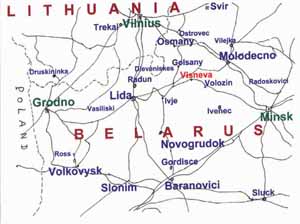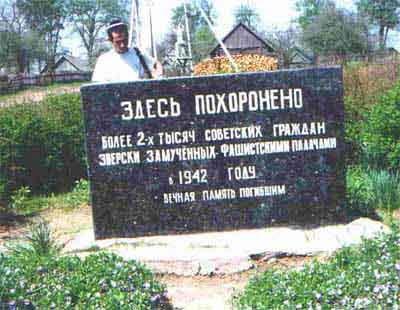GEOGRAPHY
Vishnive, formerly of Poland, is today a small town in Belarus. The town is situated between Minsk and Vilna.

HISTORY
VISHNIVE DURING WORLD WAR I
The first authoritative knowledge about the Jewish community of Vishnive is from 1844 when the community's population totaled 336 people. On August 30, 1942, the day of the town's destruction, 1100 Jewish men, women, and children were cruelly murdered.
In 1914, when the First World War began, some of the Jews were forced to serve in the Russian army.
In the summer of 1915, a fire took almost all the town's houses, including the synagogue and the bath-house. Only a couple of houses on the town's limits survived. Most of the Jews were temporarily left homeless.
On Yom Kippur, 1915, Vilna, the main city of the area, was occupied by the German army, and a few days later the Russian army left Vishnive. The town of Vishnive was in the middle of the battle area. All of the town's residents (both Jews and non-Jews) fled. Some of the people left with the Russian army for the town of Volojin, with most of them staying until the end of the war. Others tried to go back to the occupied town, but were expelled by the Germans; they went to neighboring cities instead, including: Lida, Olshan, Volkovisc, Oshmane, and more.
After the Bolshevik Revolution in Russia (1917), the Russians withdrew their forces from the area, allowing the Jews to return to the town and rebuild it. After a few months the German army withdrew from the area, enabling the Russian Bolshevik army to take over the Vilna district, including Vishnive, again. The area again became a frontline, this time between the Russians and the Polish, who took over the area after a long battle which ended only in 1921.
Read about the Rogovin and Elishkevitch families during World War I
VISHNIVE BETWEEN WORLD WAR I TO WORLD WAR II
During Polish rule (1921-1939), the Jews' life was characterized by a strong cultural, religious, and Zionist lifestyle:
The "Tarbut" Hebrew school was erected by the teachers, Chaim Avramson and Yakov-Hirsh Elishkevitch. The school taught each pupil using the Hebrew language. The young students learned not only the bible but also science. The atmosphere of the school was strongly Zionist. The religious life included two Jewish synagogues which together were open every day of the year ("beit midrash yashan" and "beit midrash hadash"), with only one synagogue open during the holidays. Apart from them were small "shtibels" of the "Slonim Hasidim." Library: the library was built in the early 1920's, and included books in Hebrew and Yiddish. In the 1930's the library was split into two parts: Hebrew and Yiddish, and then merged again. In the beginning of World War II, when the Russians came to the town, the library counted about 1800 books in Yiddish and 1300 in Hebrew. Zionist youth groups: In 1922, Chaim Avramson erected the group "He'chalutz" (a Zionist youth group) in Vishnive. The "Shomer Ha'zair" was established in 1928 by Yehoshua Rabinovitz (former mayor of Tel Aviv, and former treasury minister of the Israeli government) and Isaac Kaplan. The "Beitar" group began in the early 1930's. Zionist action: In Vishnive, Zionist action was very strong. "Keren Kayemet," and other charitable foundations, collected money from the people.
VISHNIVE IN WORLD WAR II
In August 1939 World War II began and Poland started a general mobilization. All the youths left the town. In just a few days the first runaways from Warsaw and Lodg arrived. They told the people of the community about the Nazi horror, worrying the community. The agreement between Germany and the Soviet Union about the division of Poland left Vishnive on the Soviet side. The community felt like they were saved despite knowing that the Zionist movement would stop, and the way to Israel closed. When the first Soviet army tanks came to town all the people went to welcome the soldiers with flowers. In the center of the market they made a performance, with Yacov Hirsh Elishkvitch and the Christian community's spokesman giving a number of warm speeches. Vishnive thus became a part of the National Socialist Republic of White Russia.
Life changes, ecconomic aspects: The craftsman had to organize under cooperatives, which weren't too hard to get used to. It was much harder to get used to the communal aspects: Zionist action forbidden, the "Tarbut" Hebrew school closed, and speaking in Hebrew forbidden. Two Soviet officers from Volozhin came to "purify" the library by setting to fire all the Hebrew and most of the Yiddish (exept classics) books. The Soviets also "purified" people too, by sending the "Anti-Revolutionaries" to Siberia. Afterwards, it seemed that they were the lucky ones because most of them survived the Holocaust.
THE COMMUNITY'S DESTRUCTION
In June 1941 Germany declared war against the Soviet Union. All the roads were full of runaways, but only a few people succeeded in escaping, while most of the others were killed by the Germans. When the German army approached Vishnive they bombed the town, and everyone had to flee toward the open fields. A bomb fell down over a house and killed the daugther of Hanan Osishkin. At 9:00am the German Nazi army went in to the town and ordered everyone to go back from the fields to the town immediately. From now on they started a prohibition on the Jewish community. Two weeks later the first victims fell: Shimon Levin and Lichterman were pulled out of their house by the Nazis, taken to a place called "sini-gori," and shot. The community was not allowed to bury them.
A few days later there was a rumor about a list of 80 people who were going to be executed. One night the Germans took a group of men to the Jewish cemetary. They were commanded to dig some big holes. They worked all night long and into the next morning. The next night the victims returned and were told to stand next to the holes, where they were shot in the back by machine guns. 38 were murdered in this massacre. Some of them died immediately, but many of them were only wounded. When the dirt was re-shoveled over them in their holes, one of the victims shouted: "Don't cove me, I'm still alive." A few were saved when they sneaked out of their graves. Avram Podverski escaped, without an arm. According to gentile neighbors, the ground above the holes were moving and shaking for three more days.
To see the place where the first massacre happened; the Jewish cemetary in Vishnive is the testamant.
A few days after the first massacre, the order to move to the ghetto came. The ghetto was on Karve Street, as well as the Jewish synagogue. The ghetto was surounded by a fence. It was forbidden to exit the fenced-area except for the people who went to work (in exchange for 200 grams of bread a day and an attitude).
On August 28, 1942, a group of people who worked outside the ghetto got a free day, while the others were forced to stay inside the boundary ... the people felt that the worst is coming true. On August 30, at 2am, the town was surrounded by a company of armed solidiers. By early daylight, the solidiers started to deport every one to the synagogue yard. After every one got to the yard they were told to lay with the faces down. Two people rose their heads and were shot immediately. After a few hours of laying down, there came the S.S. (Nazi) commander who was in charge of the extermination operation. He called the names of 20 people and they had to leave the yard with some soldiers. They were taken far to Karve Street, on the way to the village of Vistovitch, where there was a building under construction. There were a few tables next to the building and the victims were told to lay down on their knees and their faces to the wall. They were shot down by automatic weapons. Some died immediately, while others were wounded and blacked out. But some remained aware of their situation. All of them were thrown into the building construction area.
When people heard the sound of shots at the synagogue yard, the next group of victims who were on their way to the area, started to runaway to the forest and to the fields, but all except two or three were caught and shot by the Germans. Their bodies were left scattered all the way between the town and the forest.
There was no end to the noise and cries of despair that came from the synagogue yard, however, only a few tried to escape and save their lives. Most of the people went with no desire to live, like "folk for sacrifice." Group after group were brought to the killing place, laid down on their knees, and were shot by the automatic weapons and thrown into the construction area. When the Nazis finished, and the building was full of corpses and the wounded, they ignited the building. The news about this masscare spread fast between the gentiles, and thousands of people from all the villages in the area came to watch. They told the partisans who came to the town after the war was over that they saw many of the victims standing next to the windows begging and crying to be let out, until the building -- with the people inside -- became just ashes and dust.
YIZKOR
The people from the community who were outside the town during the destruction, and the very few people who ran away successfully to the forest, tried to connect with the partisans. Those who had success took part in some actions against the German army. There were also two acts of revenge. The first one was against two gentiles from Vishnive who were very cooperative with the Germans. They helped the Nazis find a location for the massacre, and they helped them to shoot the runaways. During the night those two had been taken out of their houses in Vishnive to the forest where a military court judged them to be executed by shooting. The second operation was against the gentiles who took over the Jewish houses after the original occupants were killed. A partisan battalion mobilzation was formed against this action. They came by night to the town. First they burned the Jewish synagouge where the gentiles made a carpentry, and immediatly after all the town was set ablaze. In just two hours the fire took all of the town (except for a few houses on the town's limits), scaring the gentile population into fleeing.
Link to:
"THE SHTETL AND I"
stories about life in Vishnive as reflected
through the Elishkevich family saga.

|